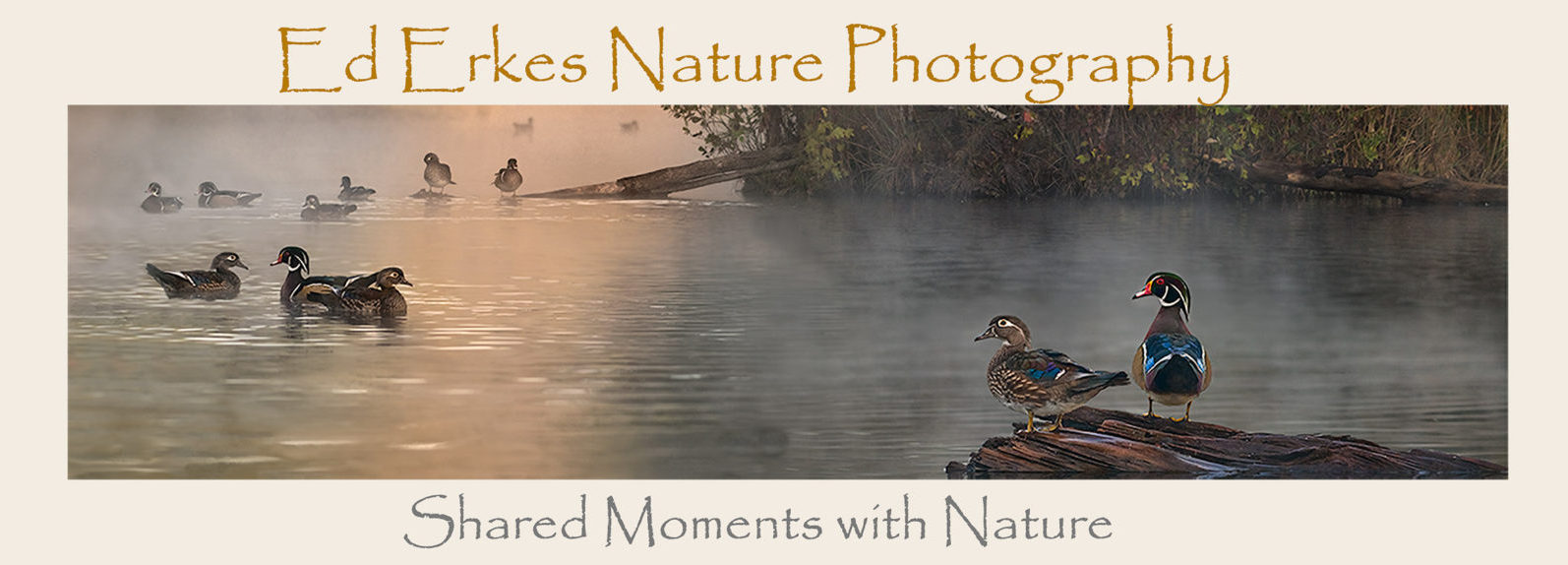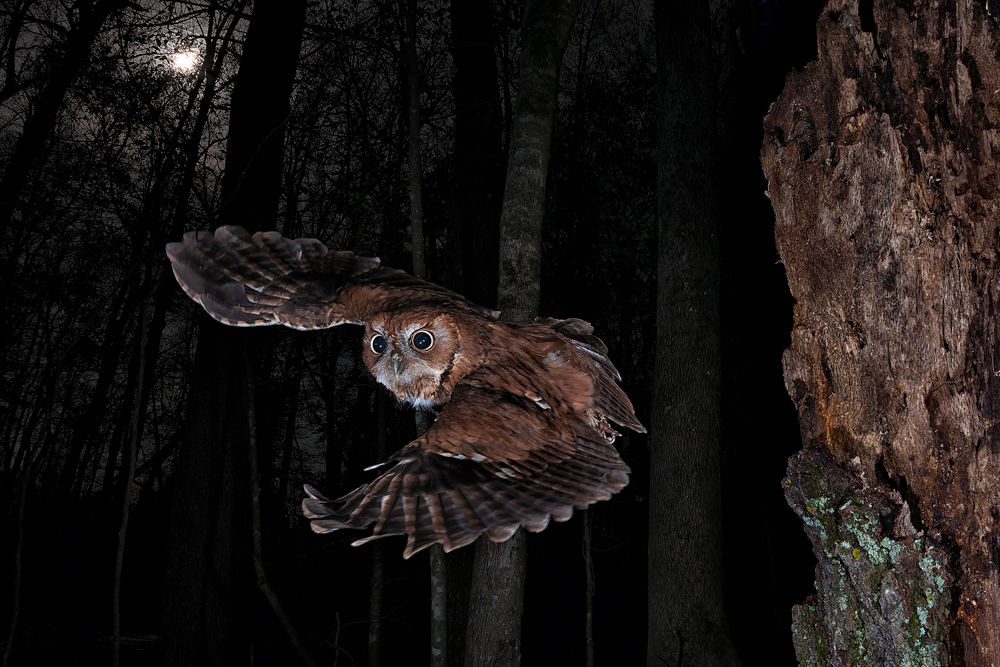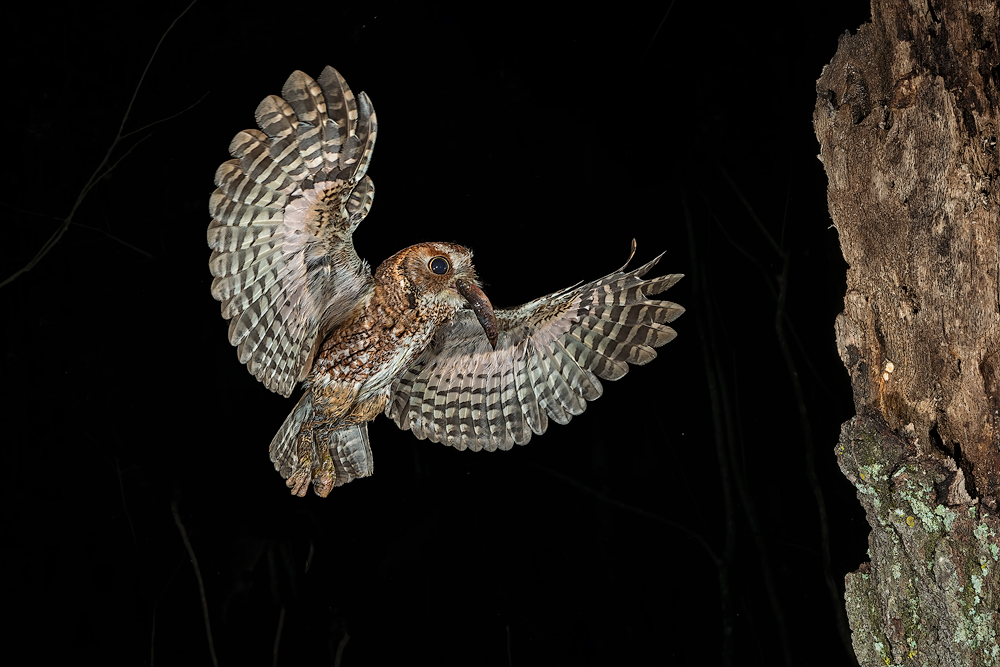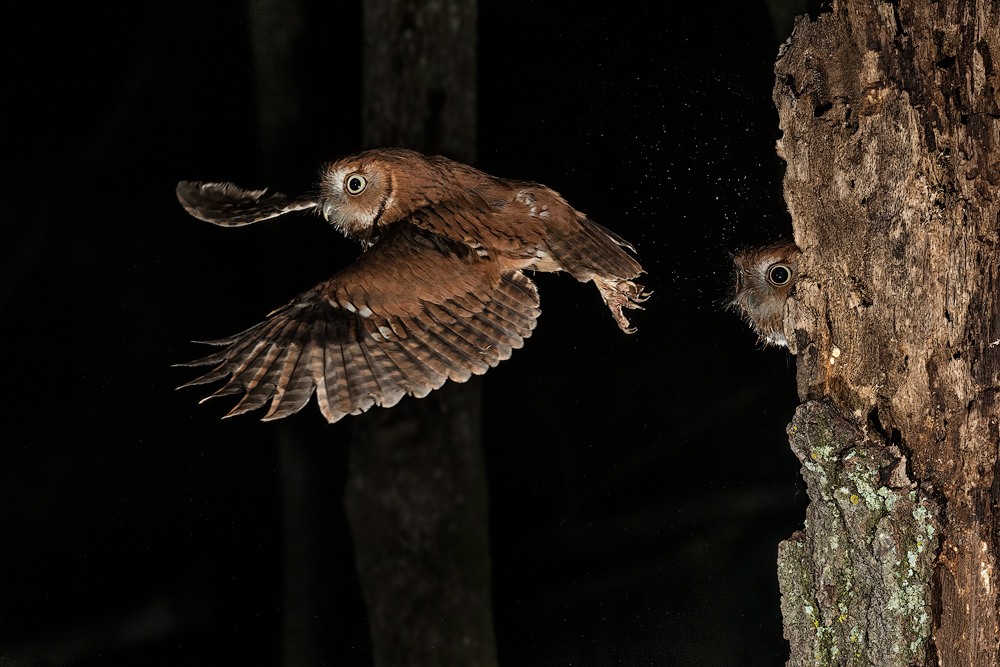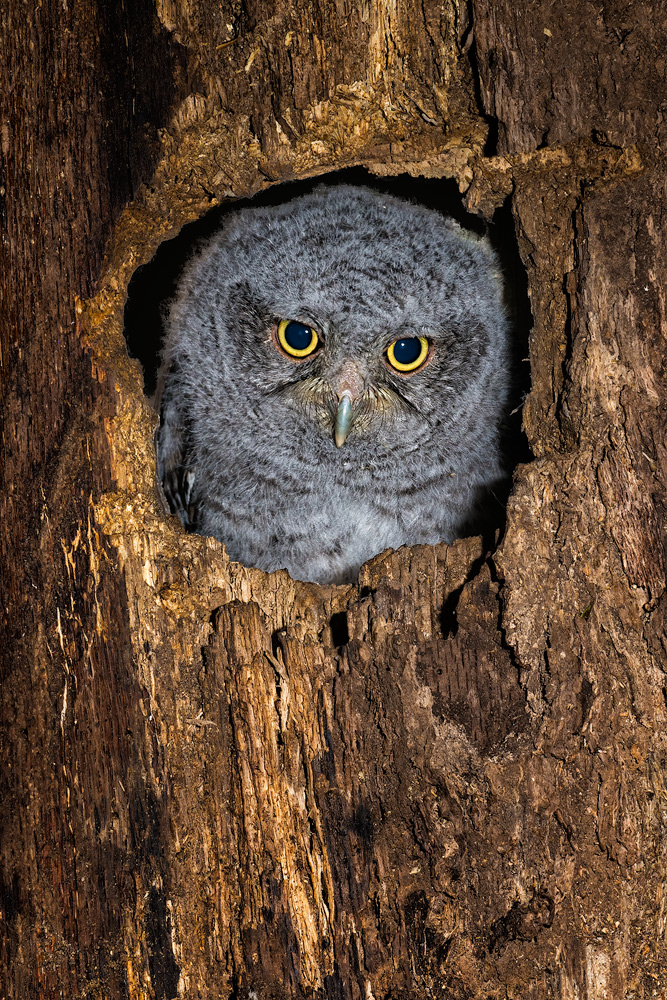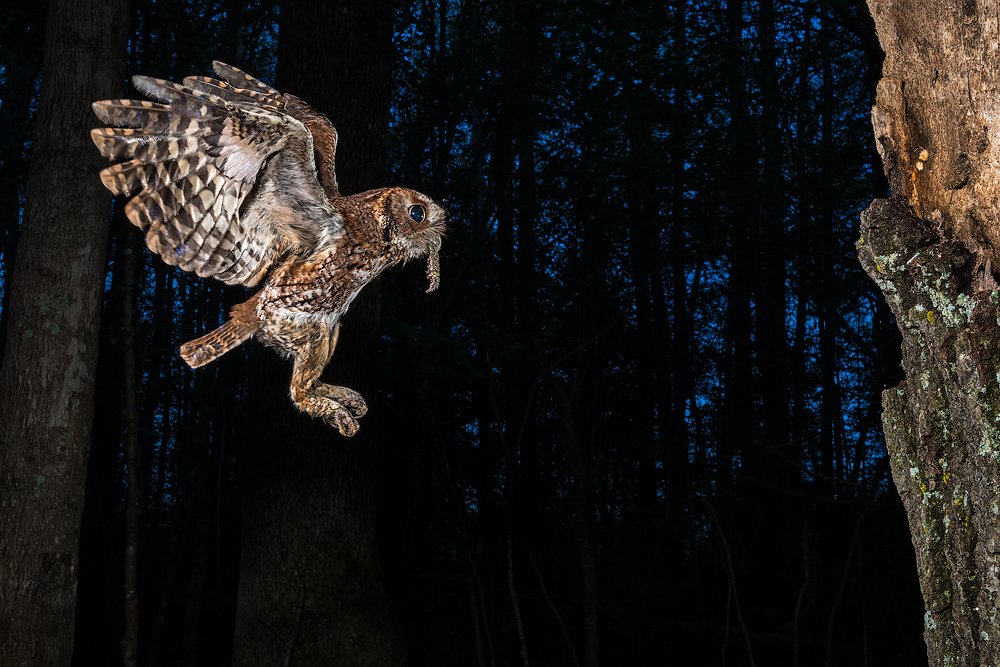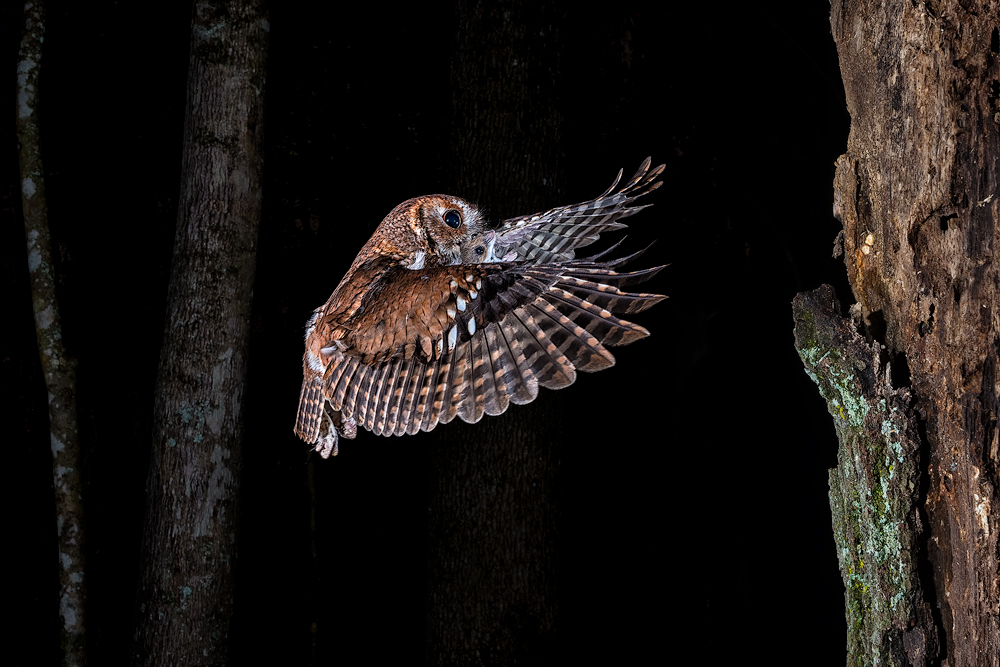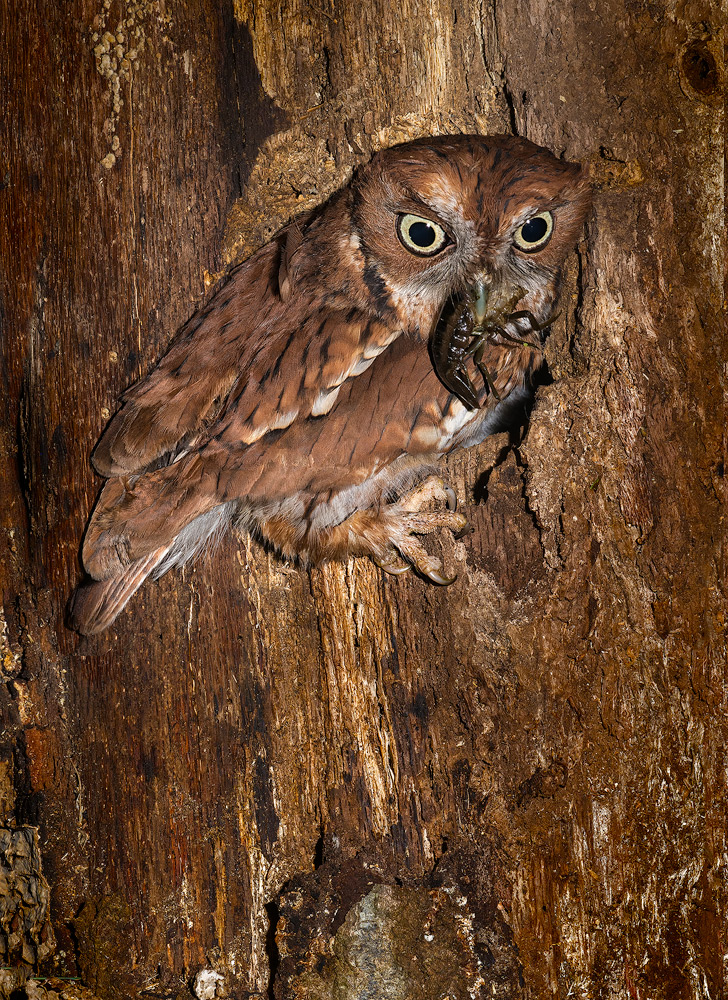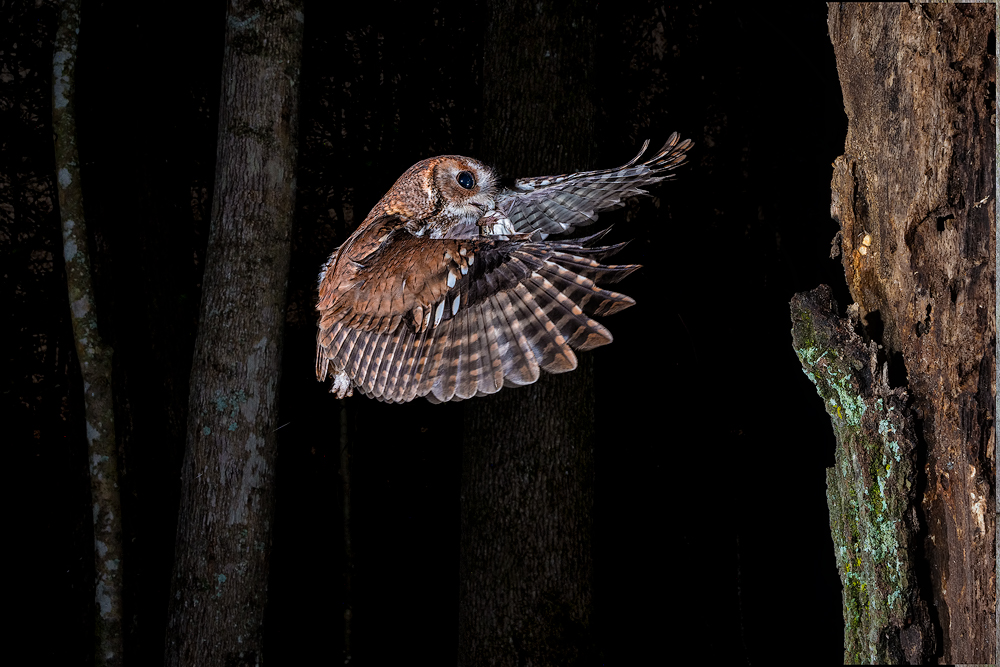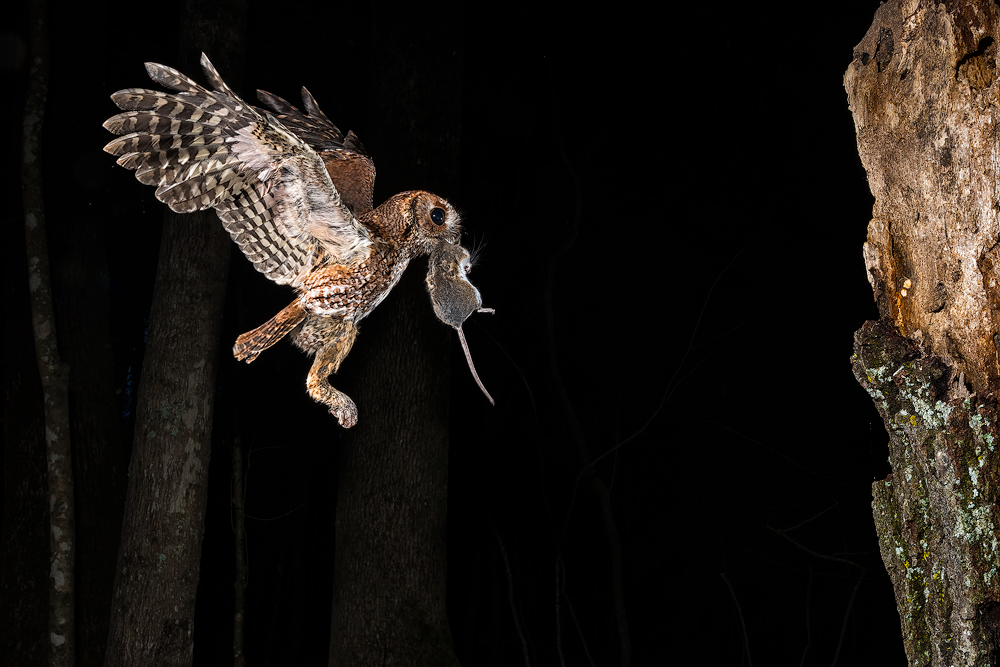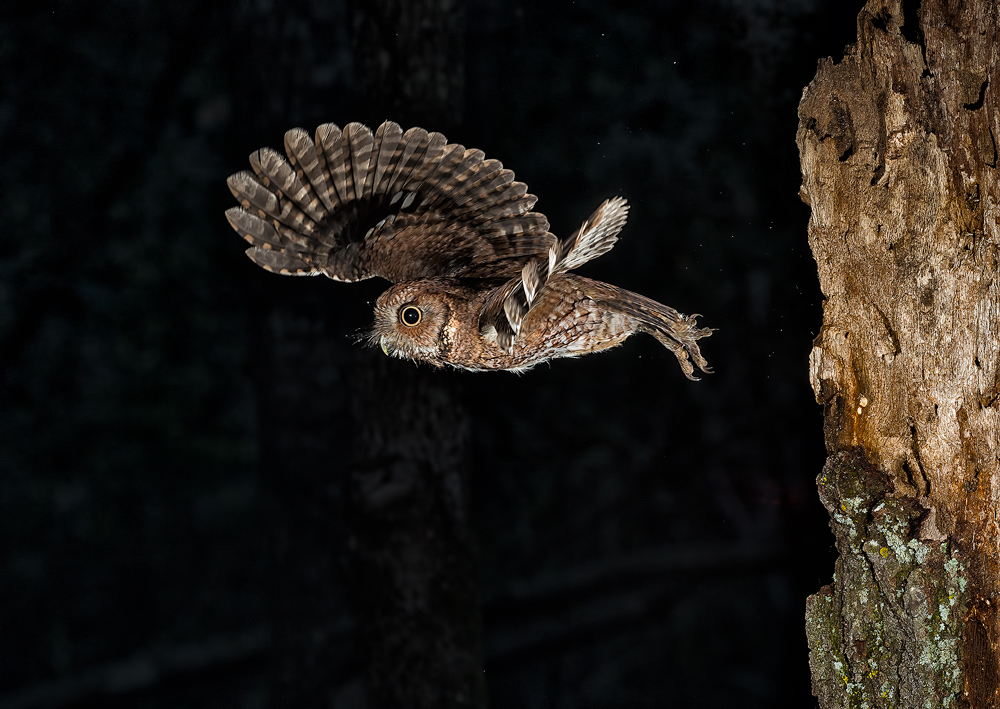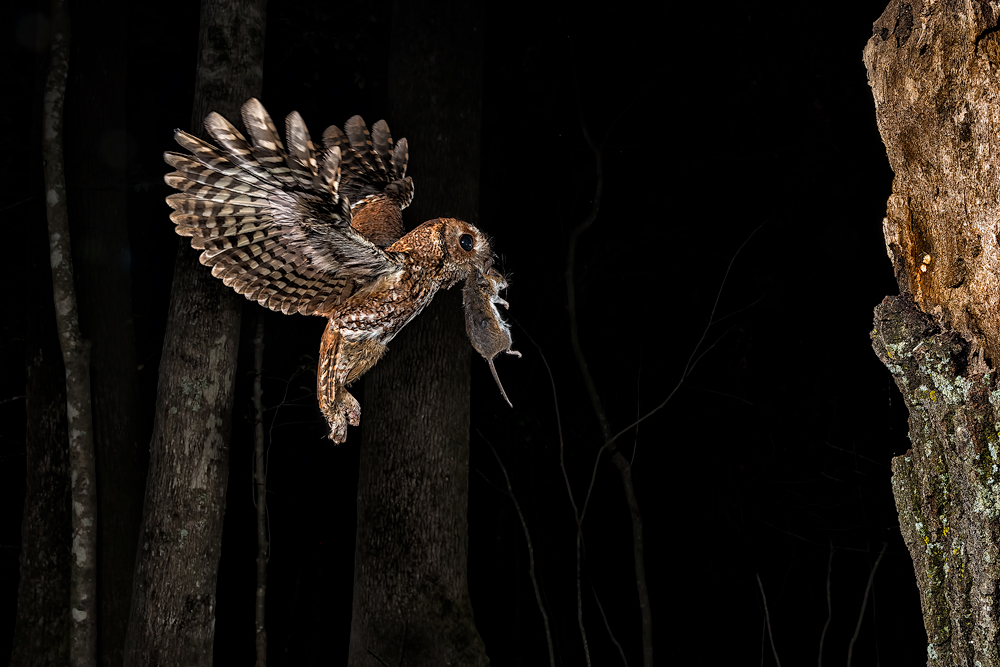The eastern screech owl is a subject that I’ve wanted to photograph for many years, with no success whatsoever. Although I’d heard their eerie and distinctive song many evenings, I had never even seen one in the wild until this year. In late January I discovered one using several wood duck boxes on my pond as roosts and nocturnal feeding stations. The only photographs I took were of the owl asleep inside a nest box. My luck finally changed in April,
when I spent six nights over four weekends photographing an eastern screech owl nest at a local refuge where I do volunteer work. The nest was located about 100 feet out in a swamp, where the water depth was two to three feet. On four of the six nights that I spent with them, I used a Phototrap infrared beam tripper, three flashes and two cameras to photograph the owls. As the owls broke the infrared beam, the flashes would fire and the images automatically recorded by the two cameras.
The equipment was set up during the day and I returned that night to monitor the nest. To ensure that the equipment did not interfere with the nightly routine of the owls, I stayed awake the entire first night and used a dim red-filtered spotlight from a distance to monitor the owls. The owls would usually land on tree branches near the nest and give their distinctive monotonic trill call (discussed later) for several seconds before flying to the nest. After several hours of observation, I turned on the equipment. The flashes did not seem to disturb the owls. They even returned to the nest on two occasions when I was changing the batteries in my cameras about 20 feet away. On the remaining three nights of Phototrap use, I either sat in a lawn chair or took naps in a sleeping bag at the edge of the swamp.
During the nights I photographed the owls, they visited the nest about every 30-45 minutes. The interval between feedings was much longer when larger prey were delivered. Prey items included insects and insect larvae, fish, crayfish, tadpoles, frogs and mice.
On the final two nights of photography I used a blind to try to photograph the nestlings at the cavity entrance. The first night I had to abort due to a severe thunderstorm that collapsed my blind. The second night I did have some success, capturing images of the nestlings and parents at the nest.
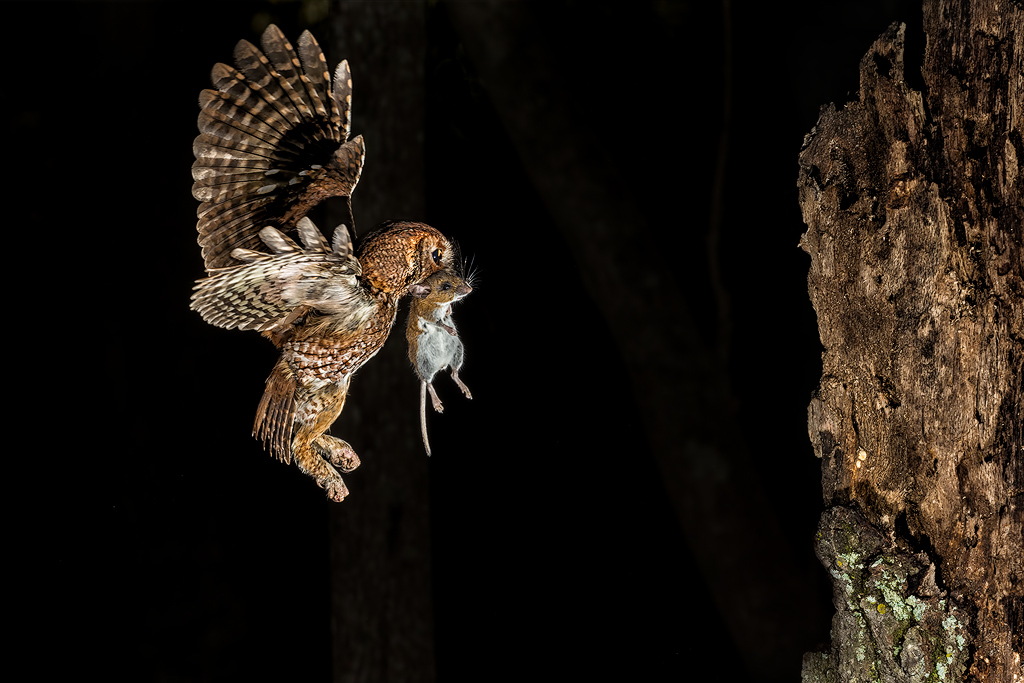
The eastern screech owl is the most common owl in eastern North America. It is a relatively small owl, with an average length of 8 1/2 inches, a wingspan of 20 inches, and a weight of only six ounces. The male owl is slightly smaller than the female, a more agile flier, and superior hunter.
Like many other species of mammals and birds, eastern screech owls in the north tend to be larger than their southern counterparts (an example of Bergmann’s rule). The larger bodies are better able to withstand colder temperatures.
Screech owls are non-migratory, permanent residents and mate for life. They are well adapted to a variety of habitats, but prefer woodlands with open sub-canopies. The open understory facilitates flight and foraging for food. The presence of nearby water is also generally a strong attractant. Their feeding/breeding territories range between 15 and 100 acres, with the size dependent mainly upon food availability. Common locations where the owls can be found include open woodlands, parks and cemeteries. The owls will readily nest in suburban as well as rural areas. In fact they thrive in suburban areas, where they utilize smaller territories and have greater nesting success. They lose less nests to predators and find food prey more easily in suburban areas.
Eastern screech owls are among our more nocturnal owls, generally leaving their nest or roost cavity 15 to 20 minutes after sunset, depending upon cloud cover. However they will forage for food sometimes in daylight, especially when providing for young. Also, the owls will often sit at their nest or roost entrance in daylight. Although aggressive in defense of young, they are often tame and docile on roost and eggs. They reportedly can be lifted from their nests (while on eggs) or roosting cavities without offering resistance. The owl roosting in the wood duck boxes on my backyard pond was quite tame. The owl would not move when I opened the nest box. The first time I saw it I actually touched the owl to see if it was alive. It opened its eyes but otherwise did not respond.
The owl is most often seen by humans when sitting at its nest/roost cavity entrance, or while roosting in trees. In trees it prefers to roost on a limb close to the trunk. It will assume a “hiding” pose when approached, sitting very upright with ear tufts erected, eyes nearly closed, and wings/feathers tight against the body, resembling quite closely an upright stick or stub. It will often maintain this pose and allow close approach (until it realizes it has been discovered).
There exist three distinct color morphs of the eastern screech owl: gray, red or rufous, and brown. Overall, gray morphs make up about 56% of the population, red morphs 38% and brown approximately 6%. The relative percentages vary in different regions of North America. Gray morphs are more common in the north while red morphs predominate in the mid-latitudes and southward—except Texas and Florida, where gray morphs are more common. The different color morphs interbreed regularly.
Vocalizations
Both male and female owls utilize the same song and calls. The male does however sing more often than the female and his vocalizations are lower in pitch. Two distinct songs have been described, a “bounce” song or “monotonic trill” and a “whinny” or “descending trill.” Although the two songs are given throughout the year, each song predominates at different times. The monotonic trill has been described as a tremulous or quavering song given all in one pitch—a monotone. It is primarily a family contact song most commonly heard in late winter through summer. It peaks twice during this period. Once in February and March, during courtship and breeding and again between mid-May through August, when owlets have fledged and the family maintains close contact. The male is said to advertise potential nest sites to his mate by trilling on perches near the cavity and even from within the cavity. The male also often gives the song as it approaches the nest with food for the female and/or nestlings. The female on occasion will sing the monotonic trill faintly while on the nest. She will also trill to induce fledging. A mated pair can sometimes be heard singing the monotonic trill alternately as a duet. Somewhat surprising, males will sometimes sing sporadically throughout the day at roosts, particularly late afternoon and early morning.
The monotonic trill can also sometimes be used as a territorial defense song. While some researchers feel that the monotonic trill is used to advertise a potential nest site to a mate, others believe it is a territorial song that the male gives to defend nest and roost sites within his territory. It is often given between neighboring males. These songs between rivals are usually given synchronously and can thus be distinguished from songs between a mated pair, which are given alternately.
The whinny or descending trill is a territorial defense song most commonly heard in late summer and fall, directed toward adjacent owl pairs and young owls dispersing to find territories of their own. It is a short tremulous song that briefly rises then falls in pitch and has been likened to a horse’s “whinny.” The descending trill is also given during the breeding season, usually by the female, to voice mild alarm toward intruders such as cats and humans.
Late during the nesting season, you may hear owls giving both monotonic and descending trills: a mixture of territorial defense toward dispersing juveniles interspersed with pair contact songs.
Screech owls reportedly sing more on gibbous and full moon nights and on evenings just before stormy weather. Singing is infrequent during the months of November through mid-January (Texas data—time period may vary as you move northward).
While I was photographing the owls, the owl bringing the food would sometimes perch near the nest and give the monotonic trill for a short period before approaching the nest. I also heard the female singing from within the nest cavity. I did not hear the descending trill.
Screech owls readily respond to playback of recorded songs and the use of recordings is the primary means of performing owl censuses. The owls will respond to both the monotonic and descending trills. Song, either the monotonic trill alone or the monotonic trill alternating with the descending trill, is generally played for five minutes or until a vocal response is heard.
Nestlings beg food with “peeps” for the first week, followed by harsher rasping calls afterward. The adult female will also give a rasping call during courtship food begging. Nestlings do not sing.
In addition to the songs and begging call, screech owls also use the following calls: chuck-rattles, hoots, barks, and screeches. The chuck-rattle is a rapid 3-4 note call, given to denote minor annoyance at mate or nestlings or some benign intruder. An example would be a chuck-rattle given in response to mobbing birds. Another would be chuck-rattles by nestlings as they compete for food. The remaining three alarm calls are in response to perceived danger. The level of danger and degree of alarm increases from hoot, to bark and finally the screech. A hoot is a soft low note usually given as several notes and denotes mild alarm. The bark is a single loud high-pitched hoot. The screech is a single loud piercing call. Note to human nest monitors: barks and screeches may be followed by an attack.
Hisses were noted by Gehlbach when handling owls. He has never heard this sound in any other context. Bill claps are a non-vocal defensive sound in response to a disturbance and may be given in conjunction with hoots, barks and screeches.
Breeding Biology
Breeding Calendar: Data from Texas (Gehlbach), timing will probably vary somewhat at more northerly locations.
Late January through early March: Nest site advertisement and courtship.
Early March through late May: Thirty day incubation period during this time
Early April through early July: One month nestling period followed by two month fledging dependency period
Early July through late September: Fledging dispersal.
Courtship behavior has seldom been observed but includes mate bowing, courtship feeding and allopreening. Screech Owls generally are monogamous and mate for life, but approximately six percent of males are polygynous—will mate and raise young with two females within its territory.
Nesting occurs between March and June, with earlier nesting occurring in the south. The male will advertise several alternate nest sites, but the female chooses the actual nest cavity to be used. In field tests, owls have been found to just as likely choose a nest box as a natural cavity.
The owls are single brooded, but will usually re-nest to replace lost clutches of eggs. If nests fail during the nestling stage, re-nesting is rare. Two to six eggs are laid, with an average clutch size of three to five. Early nests average 4 eggs while late nests (which probably include many re-nest attempts) average three. Eggs are laid every other day and fewer eggs are laid in seasons with decreased food availability. In large clutches, there may be two to three days between the laying of later eggs. The female generally begins incubation after the first or second egg is laid, with the incubation period lasting 30 days on average. Hatching is asynchronous and in years when food prey is less available, younger owlets may not survive. If disturbed during incubation, nests may be deserted; but once eggs hatch, desertion is extremely rare. During incubation the female remains in the nest except for brief 15-20 minute periods just after sunset and before sunrise. The male supplies food to the female during the incubation period.
Overall about 55% of eggs laid hatch. In rural areas the major cause of egg loss is predation. In suburbs, the major loss of eggs is desertion of the nest or chilling of the eggs because female is driven from the nest by some prolonged disturbance. The source of disturbance can be predators, pets, children, yard work in the area, etc.
The female broods the young for one to two weeks after hatching, with the brooding period shorter when temperatures are warmer (in the south and with nestings later in the season). The male continues to provide the food to his mate and nestlings during this period. Food is either delivered directly to the nest or the female flies to a designated delivery perch to accept the food. The female tears up the larger prey items and feeds the nestlings until they are large enough to dismember the prey themselves. About 20% of nestlings die before fledging; due to predation, cold weather, starvation, cannibalism, or even suffocation by larger siblings. If the female dies early in the nestling period, the nestlings usually will not survive because, although the male will continue to deliver food, he will not tear up the prey item for the nestlings nor will he brood the young.
Owlets remain in the nest for about 28 days . Fledging reportedly occurs within one hour of sunset, and is stimulated by parents withholding food, removing cached food, and singing (the monotonic trill) from nearby perches. The owlets will generally beg from the nest entrance with their rasping calls prior to fledging. They usually fledge in the order hatched, one to two per day. Although they may fledge over several days, once fledged the owlets gather and roost together. The young owls are unable to fly for two to three days after fledging and remain dependent upon the parents for eight to ten weeks.
Nesting success, defined as percent of nests that successfully fledges at least one nestling, varied in the literature, between 31% to 69%. VanCamp noted a 69% success rate in his long term study, while Gelhbach reported a similar success rate with his study of suburban owls (69%), but his success rate in the rural population was less than half that.
Fox squirrels, starlings and flickers compete and sometimes displace screech owls from roosts and nests. The owls often reclaim usurped nest cavities (about a third of the time) by simply delaying their nesting until the competitor has finished nesting.
If a nest is successful, owls will generally reuse the site next year (76% of time).
Behavior
The eastern screech owl forages for food from a number of preferred perches within its territory. The perches are within the lower levels of the trees, allowing an open view of the sub-canopy area. The owl rotates among the perches, spending a couple of minutes at each perch. It generally catches prey on the ground, trunks and lower level vegetation, utilizing its feet. It will fly-catch prey on the wing at times, utilizing its talons or beak. The prey is disabled/killed by bites to the head and neck and the head is usually consumed first. Larger prey items are often cached during winter and during nesting season. Food is normally cached in roost or nest cavities, but caches have also been found on the limbs of roost perches. Food is less commonly cached during hot weather due to risk of spoilage. The owls often feed in roost cavities because it offers protection from predation by larger owls.
Screech owls are opportunistic feeders, generally taking the most readily available prey. In suburban areas they are known to capture moths and other insects attracted to light sources such as porch lights, lighted windows, bug zappers, etc. Gehlbach observed screech owls at his home perched on balcony railings and picnic tables near light sources.
Screech owls overall are successful about 78% of time when they attempt to capture prey, however, they are far more successful capturing insects than vertebrates (83% capture rate vs 56%).
My research prior to photography revealed that screech owls vary in the number of feedings per evening. The number, in one study, ranged between 17 and 77 times a night, over seven nights. In another study over seven nights, the range of feedings was very similar: the number of feedings varied between 14 and 75. The variance appearing to be mainly due to size of prey. On the low night of 14 feedings, the owls brought in eight birds and six insects. On the night of 75 feedings, the owls delivered two beetles and 73 moths.
The eastern screech owl has the most varied diet of any North American owl. This wide range of prey is one reason the owls are so common in a variety of differing habitats across eastern North America. Invertebrates make up approximately 75% of their prey. The owls also feed on 138 different vertebrates (more than any other North American owl); including 83 different bird species and 18 mammal species (two thirds of which are rodents and squirrels). In spring and summer, the main vertebrate prey are birds. In winter mammals are the dominant vertebrate prey.
In my limited experience with the owls, there were no bird prey brought in to feed the nestlings as I was photographing them. However, for the owl roosting in the wood duck nest boxes on my pond, there were always lots of songbird feathers in the boxes.
Screech owl pellets average about 14mm by 30mm in size. The pellets are often found under favored perches and in roost boxes. Owls generally cast one to two pellets per day.
Miscellaneous Information
Mortality: About a third of adults die each year. Approximately 70% of fledglings die the first year.
Roosts: Screech owls roost in tree cavities, nest boxes, and within tree foliage. They prefer to roost in tree cavities or nest boxes because they afford better protection from the elements (cold and stormy weather) and enemies (mobbing birds and hawks). The owls usually have several alternate roost sites. If a cavity roost is not readily available the owls will roost in trees: evergreen trees in winter and either evergreen or deciduous trees in spring and summer. There is a distinct shift in preferred roost sites as the seasons change. Tree cavities or nest boxes are preferred in colder weather. Then, as temperatures rise, more owls will roost in evergreen trees. Since male owls are smaller than females and less able to thermoregulate, they often make the transition to tree roosts later than the females. As deciduous trees leaf out, the owls will also begin to roost in them. When the female is on the nest, the male will nearly always roost close to the nest, usually within a 4-6 meters. Since deciduous trees are more common than evergreen, these males are more often than not roosting in deciduous trees. The owls usually roost alone, but a mated pair will sometimes share a roost cavity in winter.
Flight: Screech owls use a low arcing flight when flying from one destination to another, as from one perch to another or from perch to nest cavity. The owl will typically drop quickly on taking flight, fly at a low level, and then rise abruptly as it arrives at its destination. It is thought that this type of flight pattern may help hide or disguise favored perches or roost/nest cavities. They typically fly 2-3 m above the ground. This low flight pattern when crossing roadways can result in collision with automobiles, and death by automobile is a major cause of owl mortality.
Territories: Screech owl territories vary between 15 and 100 acres, with the size of the territory dependent mainly upon food availability. Somewhat surprisingly, suburban territories are much smaller than rural. Within their territory a pair of owls actively defend several alternate roost and cavity sites and the immediate surrounding areas. Because the entire territory is not defended, territories of neighboring screech owls will often overlap some. In suburban areas pairs of owls have been found roosting within 30 m of one another. In rural areas, they have been found roosting within 190m. Active screech owl territories can often readily be found between February and early March by listening in suitable habitat at dusk and early evening for the monotonic trills. The location of the trilling will generally be quite close to a nest or roost cavity.
Predators: Larger owls and hawks prey on adult and young screech owls. Rat snakes, raccoons, and opossums will prey on eggs and small nestlings. Starlings will puncture eggs and eat the contents. Suburban nests are less likely to be lost to predators than rural nests.
Screech Owls and Wood Ducks: Screech owls will often use wood duck boxes as roost sites and nocturnal feeding locations (to be able to feed peacefully without fear of predation by larger owls). If the owl is not actually in the wood duck box when you check it, the presence of songbird feathers, small animal body parts, and owl pellets will reveal its use by an owl.
Screech owls will sometimes nest in wood duck boxes, but if conflict occurs, the wood duck hen is usually able to evict the screech owl. During my research on screech owls, I did find one article describing an eastern screech owl that incubated and hatched three wood duck eggs. In a nest box monitored by a video camera, a wood duck hen removed five owl eggs that a screech owl had been incubating. The wood duck removed two eggs one morning after laying the first wood duck egg. On subsequent mornings two more wood duck eggs were laid and the remaining screech owl eggs removed. The wood duck hen and screech owl were observed several mornings fighting at the nest box entrance. The screech owl eventually regained control of the nest box and incubated the three wood duck eggs until they hatched. She preened the ducklings and attempted to feed them. The ducklings exited the box within 48 hours after hatching. One duckling was taken to a local nature reserve. The other two were not located.
Nest Boxes
Those interested in putting up nest boxes to attract screech owls can readily find plans on the internet. Most utilize a floor of 8″ by 8″ or 8″ by 10″. The height of the box varies from 12 to 16 inches. Most plans call for an entrance hole of three inches in diameter. If placing nest boxes in areas where wood ducks may compete, Gelbach recommends a hole of 2 3/4″ diameter. Place some leaf litter or wood shavings in the base of the box.
I recommend placing at least two nest boxes in an area, since owls like to have alternative nest and roost sites. Place the nest boxes in an area of suitable habitat, about 3m off the ground (so that you can monitor the boxes with a small stepladder). To minimize nest loss to predators, mount nest box on a pole with a predator guard. I’ve seen photos of nest boxes placed quite close to houses (within 50-100 ft) that were successfully used by screech owls.
Monitor nests in the early afternoon when screech owls are most likely asleep. When opening the box, block the entrance with a hand or towel to prevent an owl from exiting. If an owl is present and eggs are not readily seen, gently feel under owl for eggs, then close box and leave. If owl becomes agitated, leave entrance blocked for a short period to allow owl to calm down. It should be noted that VanCamp did not recommend nest box checks during the time period when owls were typically laying eggs. Instead he recommended first checks of boxes later in the season when owls would more likely be brooding young. Gelbach, however, monitored nest boxes for forty years, checking nests generally every five days. His research involved regularly counting, measuring and weighing eggs and nestlings. He stated that he never had an owl desert a nest box with young. However, owls would readily desert eggs, if a care was not taken. Simple observation of the area at dusk will provide much information without having to check nest boxes at all. I’ve just placed two nest boxes on my property and set up trail cameras to monitor any owl activity—for use as roost cavities now and for nest activity later.
Update: In August 2015, my trail camera captured this screech owl investigating one of my nestboxes.
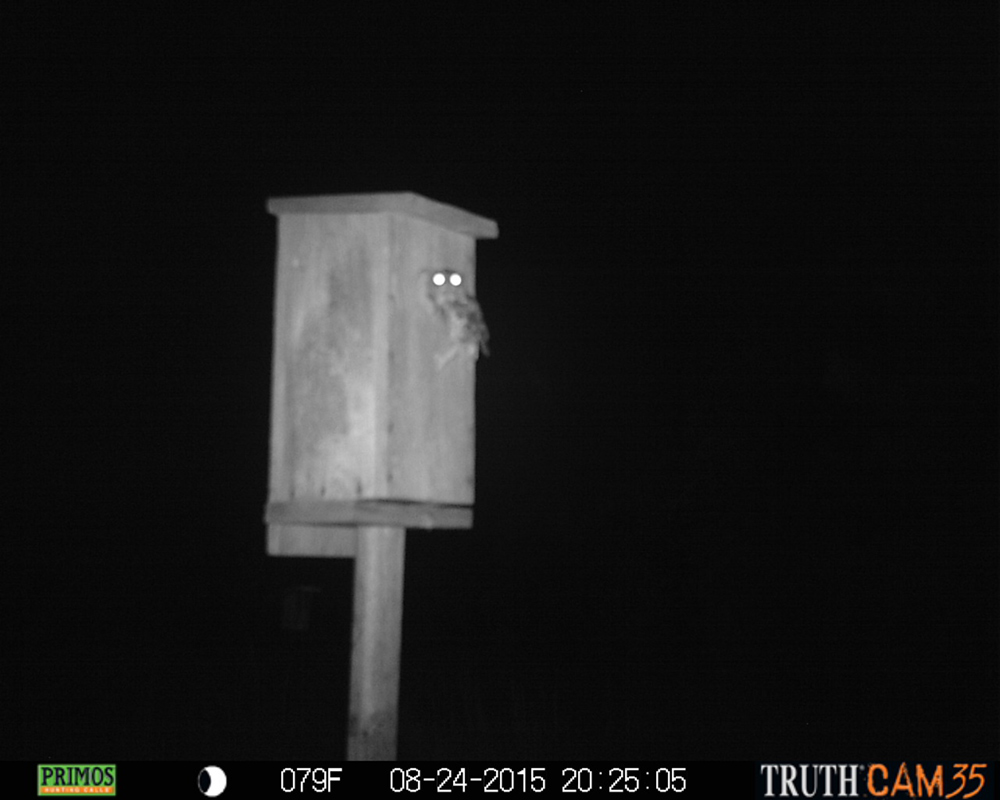
Ethical Considerations
I plan on devoting an entire article to the ethics of wildlife photography in a future blog post, but I felt some discussion was necessary here because there use of flash to photograph owls at night is controversial, with most sources currently advising against it.
Hopefully all who photograph nature and wildlife do so with a sense of respect, appreciation, and even love for the natural world around them. If so, then the last thing anyone should want to do is cause harm to subjects they are photographing. Humans are viewed by most wildlife as a source of danger, a potential predator. Our mere presence will often induce stress on the more wary of our wildlife species, just like the presence of any number of other animals for a particular species.
Below is a description of my personal philosophy, which I posted on an online nature photography forum several years ago:
“My own personal guide is to cause no physical harm to an animal or its reproductive success. To think that we can photograph birds and other animals without causing stress at all is, in my opinion, naive. In my area of the country, I obviously stress a lot of birds just scouting around, because almost every great blue heron, kingfisher, red-tailed hawk, or wood duck that even sees me in my car or on foot at a great distance flies off. The only way not to stress them is to stay home. Birds and animals are used to disturbances. It is a part of their daily life. Fishermen, bicyclists, hikers, lawnmowers and hedge trimmers, picnickers, predators, rivals, weather, etc. all cause stress and disturbance. The problem is not the disturbance or stress itself, but degree of the disturbance. It is usually repeated and prolonged disturbance that prevents the normal behavior of animals in feeding and raising young. Care must be used to minimize disturbance, and if the animals do not accept you, you must be ready and willing to back off. Also, in heavily visited areas, one has to be conscious of the potential cumulative effect of other photographers, birders, etc.”
The key point to remember: the only way you can tell for certain that your activities are not disturbing the animal is to know its normal behavior. And the way to understand normal routine is through research and observation. Research will provide the normal behavior for a typical member of the species. Observation (from a distance, preferably with binoculars) will provide you the routine for this specific individual or individuals. I usually spend at least one to several hours observing before I attempt any photography of a nesting bird. If my activities alter the routine, I abort the project.
The controversy about the use of flash on owls involves the effect on their night vision. A few have voiced the fear that the flash will blind an owl to the extent that it may crash into trees or other objects. History does not support this concern since the use of flash on owls has been practiced in bird photography for many years and described in the literature on bird photography dating back at least to the 1930’s. The almost universal description given by experienced photographers is that although the flash may cause a momentary hesitation on the part of the owl, it quickly resumes normal behavior. During my photography of the owls, I had three flashes that fired when an owl crossed an infrared beam placed eighteen inches in front of the nest cavity. I could discern no alteration in behavior at all.
A more valid issue is whether flash impairs night vision to the extent that it could hinder an owl in its ability to hunt and thus provide food for itself and nestlings. There is no doubt that flash causes constriction of the pupils and affects night vision somewhat. The degree of impairment and how long it lasts is not known. The studies I’ve read all involved long-duration light sources such as spotlights, and not the extremely short flashes of light (on the order of 1/5000 to 1/10,000 second) used in photography. Factors to consider in the use of flash include duration, intensity–which varies inversely with the square of the distance, ISO used for recording the image, and angle of incidence. A full-fontal long duration spotlight would obviously have a much more significant effect than a short duration, low intensity flash that lights the scene from a 45 degree angle. The high ISOs possible on modern cameras would reduce the effect even more by allowing even lower flash exposures.
My plan was to halt photography if the owls did not return regularly with food to the nest. My research prior to photography revealed that the number of feedings varied greatly each night, dependent upon size of prey. I needed to make sure the number of feedings with my owls were consistent with the literature. And yes, the number of images captured per night by my cameras were within the range described by the studies. I was particularly pleased to see the number of mice brought in by the owls, since vertebrate prey are noted to be more difficult to capture. Additionally, while observing the nest that first night with a red-filtered flashlight, I noted a number of times when the owls missed the infrared beam when they brought food to the nest. So obviously all feedings weren’t captured by the cameras and the actual number of feedings was greater than that recorded by the cameras.
I do not recommend the use of flash on owls if one is not able to take the care and effort necessary, which involves observation prior to and during photography and the use of cameras capable of using high ISOs coupled with low intensity flash exposures.
References
The Eastern Screech Owl: Life History, Ecology, and Behavior in the Suburbs and Countryside. Frederick Gehlbach, 2008. Prof. Gehlbach is the expert on eastern screech owls, having studied them for over 40 years.
The Eastern Screech Owl. The Birds of North America Online. Frederick Gehlbach. 1995. http://bna.birds.cornell.edu/bna/species/165
VanCamp, L.F. and Henny, C.F. The Screech Owl: Its Life History and Population Ecology in Northern Ohio. North American Fauna, No. 71, 1975. This 71 page publication can be viewed online at http://fwspubs.org/doi/pdf/10.3996/nafa.71.0001
Birds of Forest, Yard, and Thicket. John Eastman. 1997
A Guide to Bird Behavior, Vol III. Stokes Nature Guides. Donald and Lillian Stokes. 1989.
Birds of an Iowa Dooryard. Althea Sherman, 1952.
Life Histories of North American Birds of Prey, Part II. Arthur Cleveland Bent, 1938. Note: Many of the species biographies assembled and written by the author, and published in 21 volumes of the Life Histories of North American Birds, are now available to read (for free) online at birdsbybent.com
Ritchison, G., P. M. Cavanagh, J. R. Belthoff, and E. J. Sparks. The singing behavior of Eastern Screech-Owls: seasonal timing and response to playback of conspecific song. Condor 90:648-652, 1988.
Ritchison, G. and P. M. Cavanagh. Prey use by Eastern Screech-Owls: seasonal variation in eastern Kentucky and a review of previous studies. J. Raptor Res. 26:66-73, 1992.
Pittaway, R. Morphs of the Eastern Screech-Owl. Ontario Birds 13(2)0:66-71, 1995. Viewable online at http://www.jeaniron.ca/Owls/2014/morphscreech.htm
A Contribution to the Life History and Economic Status of the Screech Owl. Arthur A. Allen. The Auk, 41(1):1-16, 1924.
Eastern Screech-owl Hatches Wood Duck Eggs. Christian Artuso. Wilson Journal of Ornithology, 119(1):110-112,2007.
Effects of Flash on Owls. Bob Atkins. Photo.net, 1998. http://photo.net/learn/nature/owlflash
All About Birds: Responsible Bird Photography. http://www.birds.cornell.edu/AllAboutBirds/bp/guidelines
Flash Photography and the Visual System of Birds and Animals. Dennis Olivero and Donald Cohen, NatureScapes.net, 2004. http://www.naturescapes.net/articles/health/flash-photography-and-the-visual-system-of-birds-and-animals/
